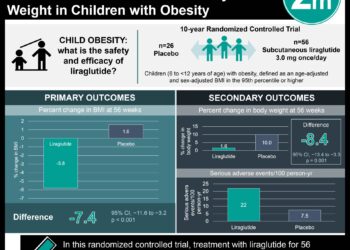Adolescents’ muscle strength associated with lower cardiometabolic risk
Image: PD
1. Children and adolescents with higher normalized strength had fewer risk factors associated with future development of metabolic disease.
2. Boys and girls with higher strength-to-BMI ratios had smaller waist circumference, higher levels of cardiovascular fitness, lower body fat percentage, and significantly lower clinical markers of cardiometabolic risk.
Evidence Rating Level: 2 (Good)
Study Rundown: Childhood obesity is an increasingly widespread problem that has far-reaching effects on health. First line treatment for obesity includes increased cardiovascular activity and diet modification as a means to mitigate the risk of developing metabolic syndrome. Given that weight trends tend to follow children through adulthood, early intervention is key in decreasing this risk. This study uses a cardiometabolic risk score (MetScore) to identify associations between normalized strength and cardiometabolic risk clustering in adolescents. Results indicate that adolescents with greater strength-to-BMI ratios had lower cardiometabolic risk scores. Boys and girls with greater strength capacity had the lowest body fat percentages, BMIs, waist circumference, and significantly lower clinical markers for cardiometabolic risk. These findings suggest a role for early resistance training in cardiometabolic disease prevention. Though this is one of the few studies to assess the potential relationship between strength and cardiometabolic risk, some limitations include its limited assessment of strength and self-reported levels of physical activity.
Click to read the study published today in Pediatrics
Relevant Reading: Muscular strength in male adolescents and premature death: cohort study of one million participants.
In-Depth [cross-sectional study]: This cross-sectional study included 1491 children from 17 Michigan schools enrolled in The Cardiovascular Health Intervention Program (CHIP) between 2006 and 2008. Participants were between 10 and 13 years of age, 95% were Caucasian, and 53% were female. Forty-two percent of subjects were overweight or obese. Cardiometabolic risk was calculated into a “MetScore” based on 5 clinical parameters: fasting glucose, systolic blood pressure, serum triglycerides and HDL, and percent body fat. Each parameter was given a weight (loading coefficient) corresponding with its relative effect on cardiometabolic risk, with body fat percent carrying the highest loading coefficient. Physical activity categorization (active and inactive) was based on self-reports during patient screening. Strength was assessed via hydraulic handgrip dynamometer and participants were divided into tetriles corresponding to low, moderate, and high strength. Boys and girls in the high strength tetrile had statistically significant lower BMI, waist circumference, and percent body fat compared to low and medium strength groups (p < .01). Normalized strength was compared to both the MetScore and individual factors associated with cardiometabolic risk; higher BMI (β= 0.30), physical inactivity (β= 0.30), and lower normalized strength capacity (β= -1.5) were significant predictors of increased MetScore (p < .05).
More from this author: Observation of mobile device use among caregivers at mealtime, Bullying associated with poorer health among middle school children, Caffeine intake among youth remains stable, but sources vary
©2012-2014 2minutemedicine.com. All rights reserved. No works may be reproduced without expressed written consent from 2minutemedicine.com. Disclaimer: We present factual information directly from peer reviewed medical journals. No post should be construed as medical advice and is not intended as such by the authors, editors, staff or by 2minutemedicine.com. PLEASE SEE A HEALTHCARE PROVIDER IN YOUR AREA IF YOU SEEK MEDICAL ADVICE OF ANY SORT.






